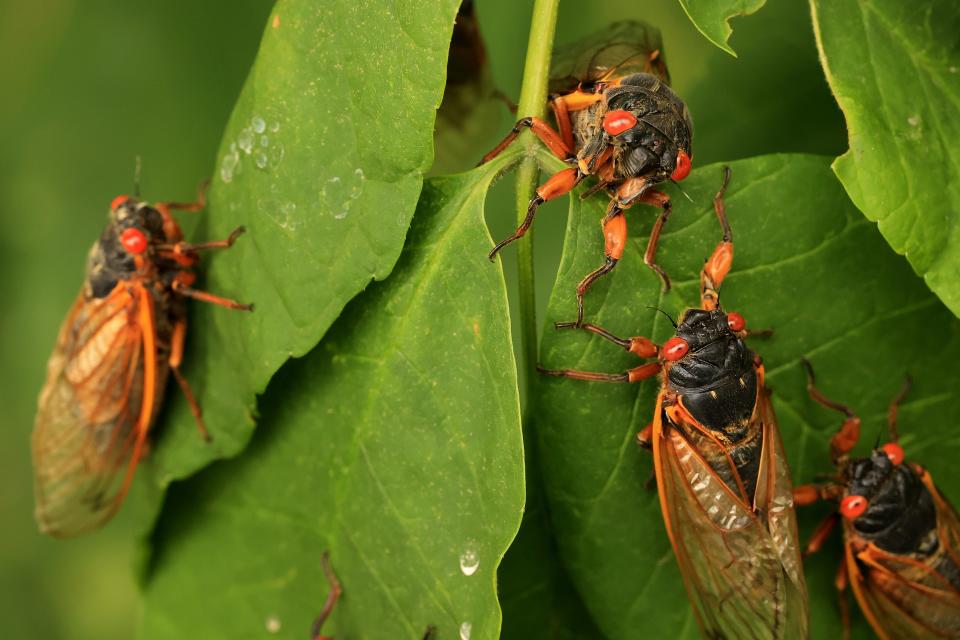Cicadas 2024: This year's broods will make for rare event not seen in over 200 years
- Oops!Something went wrong.Please try again later.
2024 is the year of the cicada.
In the coming months, certain states will experience a rare natural event that hasn't occurred in over 200 years: The emergence of two separate broods of cicadas.
After 13 years, Brood XIX is set to emerge in the spring of 2024 in 14 states across the Southeast and Midwest, and the 17-year Brood XIII will emerge in five Midwestern states around the same time, according to Cicada Mania.
This double emergence is the first time this has happened in 221 years. According to ScienceAlert.com, this won't happen again until 2245.
These two broods are different from Brood X, which you may remember emerged in the summer of 2021 across multiple Eastern, Southern and Midwestern states.
Here's what to know about the two broods of cicadas gearing up to return above ground this May.
'Trillions' of cicadas? See how and where dual cicada broods will emerge in 2024
What's special about the cicadas this year?

The rare, double-brood event hasn't happened for over 200 years. It last occurred 221 years ago, in 1803.
The U.S. looked very different then: Thomas Jefferson was president, the Louisiana Purchase had just been completed and there were only 17 states in the union.
To put that into perspective, the last time the double brood emerged, the U.S. was still 58 years away from the start of the Civil War and 166 years from Neil Armstrong stepping on the moon.
This rare, double emergence of broods won't happen again until 2245.
When will the cicadas come out in 2024?
Brood XIX (19) is estimated to emerge beginning mid-May and lasting through late June. The brood last emerged in 2011, and has a 13-year life cycle.
Brood XIII (13) will emerge in mid-May and ending in late June, and unlike the other brood, these cicadas have a 17-year life cycle. They last emerged in 2007.
Where will the cicadas emerge?
Although the broods will emerge in a combined total of 17 states, that doesn't mean all areas of every affected state will see cicadas. A majority of Missouri counties will see Brood XIX, but only a few counties in states like Louisiana, Indiana, Michigan, Kentucky and Tennessee may see any cicada activity.
Brood XIX is the more widespread, with cicadas emerging from Oklahoma to Alabama and North Carolina.
The broods (Brood XIX and Brood XIII) will emerge in the following states:
Alabama
Arkansas
Georgia
Illinois
Indiana
Iowa
Kentucky
Louisiana
Michigan
Mississippi
Missouri
North Carolina
Oklahoma
South Carolina
Tennessee
Wisconsin
Virginia
Cicadas in Illinois
Of all the states where both broods will emerge, they are expected to overlap in Illinois and Iowa.
In Illinois, Brood XIII will be mainly concentrated in the central and northern parts of the state, and the brood is also expected to be found in neighboring states Wisconsin, Indiana and Michigan. Brood XIX will be mainly found in the central, southern and eastern areas of Illinois, with the brood also emerging in nearby Missouri and Kentucky.
Iowa will mostly see Brood XIII in the eastern portion of the state along Illinois. A small area along the Missouri border may also see Brood XIX.
Cicadas 2024 map
The map below shows the approximate locations for broods emerging in 2024.
How long will the cicadas be around?
It depends on the weather and location, but both massive broods will emerge starting in mid-May and ending in late June.
If the weather is consistently warm and dry, the cicadas will finish mating sooner rather than later, which would mean a shorter season. Typically, their lifespan is four to six weeks, and they will start to die off in late June.
What's the difference between annual and periodical cicadas?
There are two types of cicadas that are common in Eastern U.S. states: Annual and periodical cicadas. Annual cicadas emerge every year, while periodical cicadas emerge every 13 or 17 years, according to the U.S. Environmental Protection Agency.
This article originally appeared on USA TODAY: Cicadas 2024: When and where 2 broods will emerge this spring

